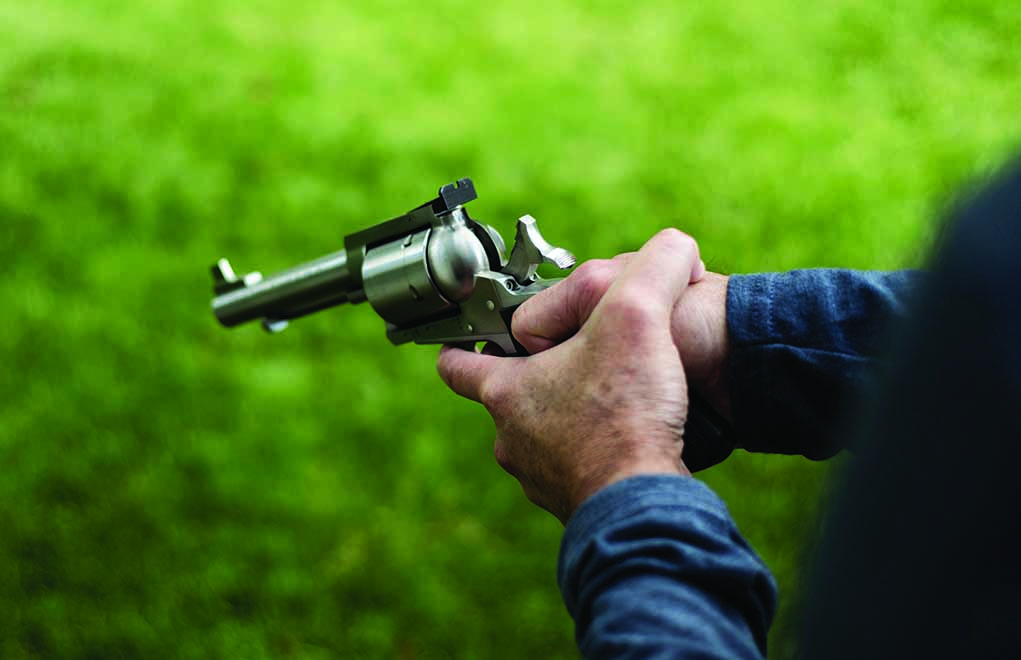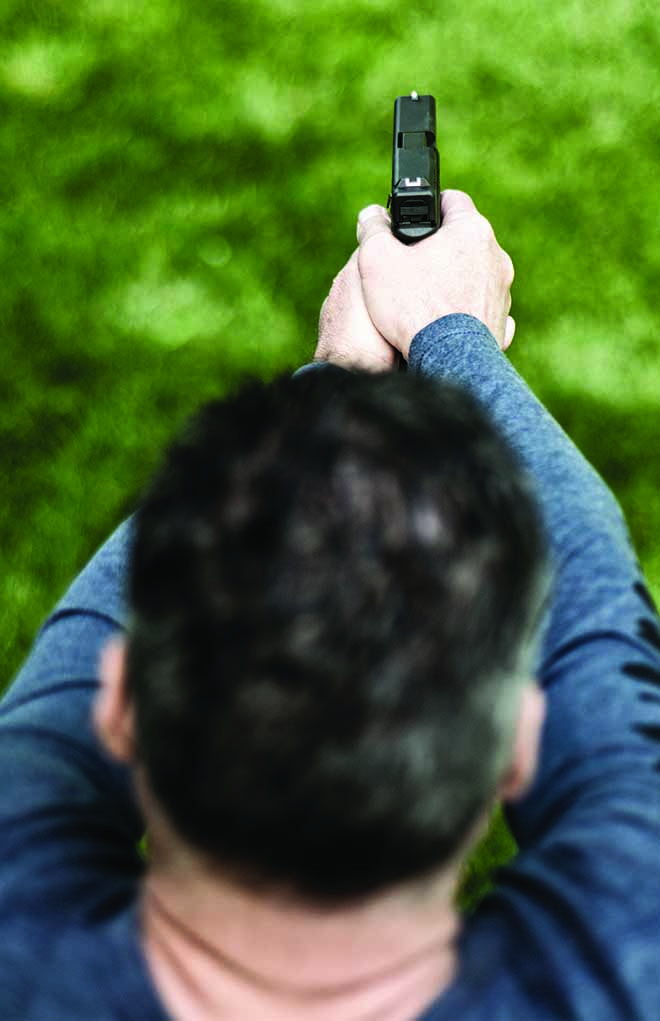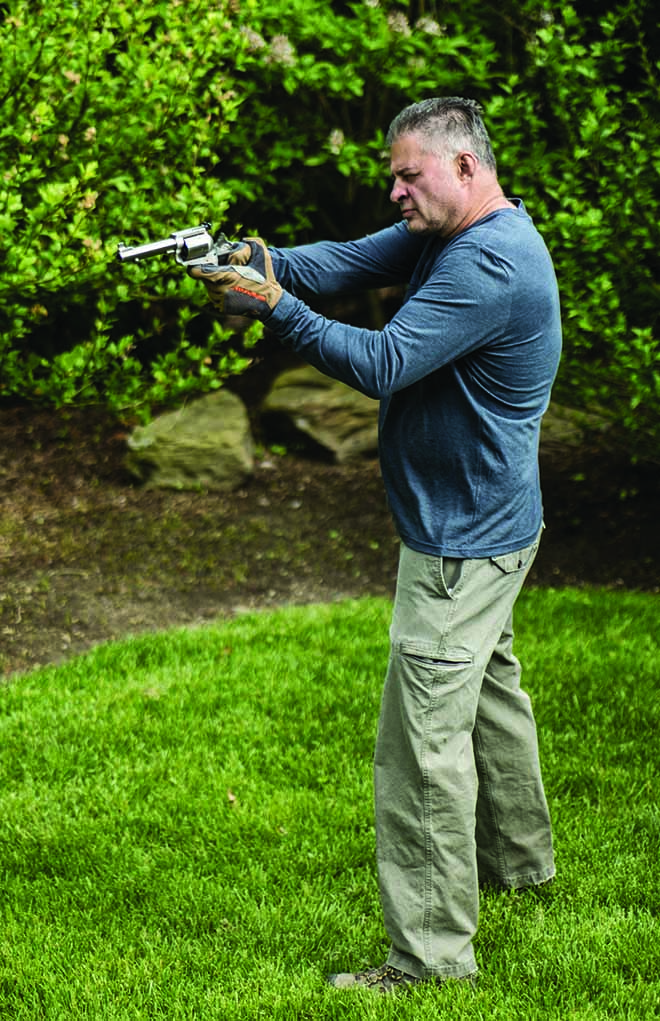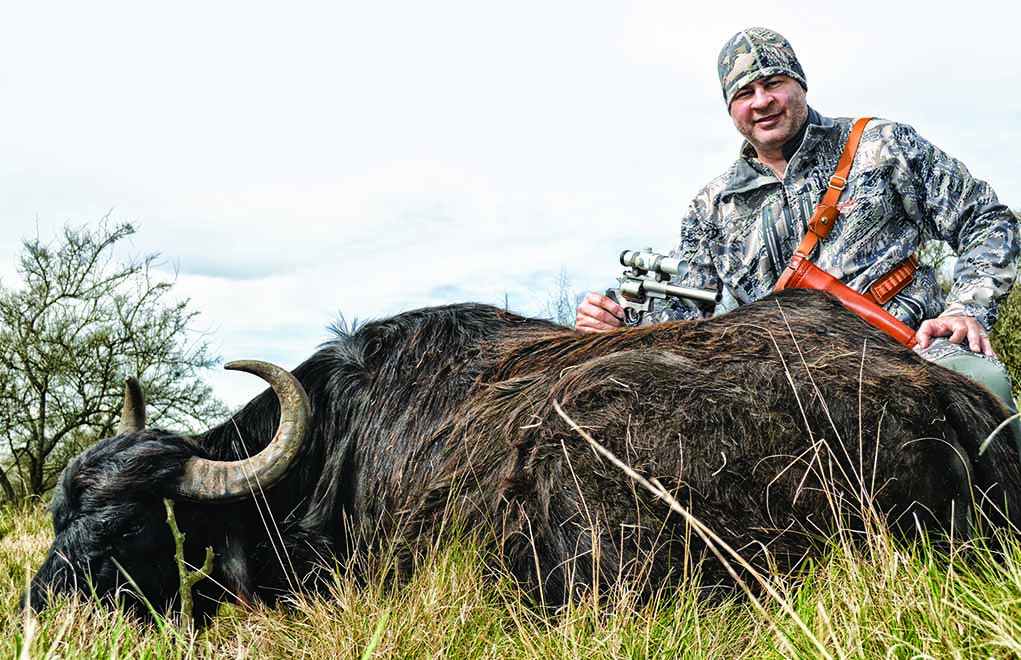
They're called hand cannons for a reason. Learn how to tame big-bore revolver recoil.
This is a topic that just won’t go away, particularly because of the rising popularity of handgun hunting in big-bore revolver shooting, as well as figuring out the best way to handle the heavy recoil associated with the more-powerful handgun cartridges.
Let me put this upfront: Shooting a handgun accurately is much more difficult than is a rifle. Shooting a handgun with outsized recoil is even more difficult and very challenging … to put it mildly. What isn’t difficult is developing a debilitating flinch from shooting these heavy recoil-generating hog-legs. You won’t have the luxury of using your body to stabilize the firearm by bracing the buttstock firmly into your shoulder. But this is obvious.
There are a number of contributing factors to revolver recoil:
- Weight of the revolver
- Grip type/shape
- Bullet weight
- Bullet velocity
Platform Options
Many manufacturers offer double- and single-action big-bore revolvers. Smith & Wesson, Taurus and Ruger all produce double-action revolvers from .44 Magnum on up. On the single-action front, Ruger, Magnum Research (BFR) and Freedom Arms all offer big-bore revolvers. While there are others, these manufacturers produce the widest variety, hands down.

There are obviously variances in grip shape among all these differing platforms. However, some generalizations are possible. For example, double-action revolvers tend to recoil back into your hand, whereas single-actions will raise the muzzle and pivot upward.
Cartridges to Contemplate
When folks think of hard-kicking revolvers, they automatically think .44 Magnum—the “grandfather” of modern magnum revolver cartridges. From the recoil standpoint, I’ve always considered the .44 Rem. Mag. a threshold cartridge that’s clearly over the limit for many. No doubt, when loaded to specs, the .44 Rem. Mag. will remind you it’s there with every stroke of the trigger.
Moving up to the various .45s (including .45 Colt +P-type loads), the real standout is the .454 Casull, the high-pressure wonder cartridge of the late, great Dick Casull. The 65,000 psi pressure limit ensures snappy (read: violent) recoil impulse, particularly when combined with 300-plus-grain bullets. It goes up from there with the .460 Smith & Wesson Magnum, although its saving grace is the size of the platform its big case necessitates, adding recoil-absorbing weight.
Going further up to the various .475s and .500s just brings more recoil. However, some of the revolvers chambered in the bigger cartridges have weight that aids in taming recoil. The big .50s (such as the .500 JRH, .500 Wyoming Express, .500 Linebaugh and .500 Smith & Wesson Magnum) loaded warmly generate sizable kick that’s definitely not for the neophyte.
Get Into Position
I want to focus on shooting offhand, because this is largely what you’ll do when going to the range. This is also the most productive practice you can conduct before heading to the field.

The two reigning offhand shooting stances are the Isosceles and the Weaver stances.
Isosceles Stance: The Isosceles puts both of your feet on line (actually, the latest trend is to drop the strong-side foot back a bit—but not as severely as with the Weaver stance) while you face flat toward the target with both arms parallel and straight out or slightly bent. Equal pressure is applied to the gun in a 360-degree fashion. It’s great for defensive shooting but not so good with a heavy revolver that generates a lot of recoil. When someone is standing flat in front of you, pushing that person off balance is rather easy. Recoil can also push you off balance if you’re standing with your feet on line.
Weaver Stance: The shooter using the Weaver stance pulls the revolver with the weak hand and pushes it with the strong hand. I use a modified Weaver with my weak side forward and my supporting elbow nearly tucked to my side. The Weaver, at least for me, is more logical and comfortable, and the kickback of a recoiling revolver can’t push you off balance. I boxed for a couple of decades, and a fighting stance—leading with the weak side—is natural for me, and it’s a position I automatically assume.
I use and practice a variety of field positions and also shoot off the bench. However, I limit my time on the bench to sighting-in and testing various loads for accuracy. Bench shooting places a lot of stress on the shooter, as well as the equipment, and should be limited accordingly.
Know How to Hold ’Em
Popular today with shooting semi-auto pistols is laying the shooting thumb along the side of the pistol, with the supporting-hand thumb underneath and alongside. Again, this is a great grip for semi-autos that don’t generate a lot of recoil, but it’s not so good when shooting a revolver that kicks. This also keeps the supporting-hand thumb from getting whacked by the slide as it moves rearward and cycles the pistol (a problem clearly not associated with revolvers).

My grip is rather unorthodox (see the photo on the facing page). My supporting hand plays a very significant role in controlling the movement (or lack thereof) of the revolver. My left hand helps support the revolver’s weight, but I also wrap the thumb behind my shooting hand’s thumb. This keeps both hands on the revolver through the recoil; otherwise, the revolver will break your grip.
This is all in the name of control and fast follow-up. If the revolver gets away from you, it can crease your skull. It’s happened to me while shooting an absurdly powerful revolver that was chambered in .50 Alaskan. It was able to push a 525-grain bullet out past 1,600 fps, and it was “contained” by a revolver weighing fewer than 4 pounds.
Additionally, in the name of consistency (not to mention speed), my supporting hand’s thumb does the cocking. As a result, I won’t disrupt my grip.
Gun Down More Handgun Hunting Info:
- Serious Big Bores: Beyond the .44 Magnum
- Video: Choosing A Big-Bore Revolver Holster
- Hunting: The Hard-Hitting .45-Caliber Revolver Cartridges
- Is A .50-Caliber Handgun Actually Good For Anything?
Grip Tension
I have a tendency to use a considerable amount of grip tension. I don’t let the revolver ride or fly up under recoil. I use enough grip strength to keep muzzle flip to a minimum, thereby enabling fast follow-up shooting.

Everything I do is in the context of hunting. I’m not one to admire my own handiwork; rather, the point is to get another bullet downrange and into the animal if possible. I don’t grip the revolver so hard that I’m shaking, but enough so that no matter the rest I’m using, or if I’m shooting offhand, my point of impact remains the same. This is my key to consistency.
I often hear folks complain about sore wrists from shooting the big boomers. Clearly, they’re allowing their wrists to articulate through the recoil impulse. My wrists never hurt, because I don’t allow them to bend while I’m shooting. Instead, I allow my elbows to articulate—but not a lot, because I’m concerned about getting back on target as quickly as possible. This will also lessen the perceived abuse meted out by heavy recoil.
Recoil Mitigation
There are many ways recoil can be lessened (or “tamed”). The most obvious option is downloading. But, in the context of this article—and greatly defeating the purpose of this article—we won’t be discussing “neutering” your big-bore revolver as an option.
Here are a few ways to lessen recoil that work alone or in total.
Muzzle brake/porting. A good, well-designed muzzle brake will do wonders for reducing recoil, but it comes with a cost: a significant increase in noise. Keep in mind that the higher-pressure rounds such as the .454 Casull, along with the .460 and .500 Smith & Wesson Magnums, already produce ear-splitting noise and should never be shot without hearing protection.

A brake makes it even worse. Porting, on the other hand, is a completely different animal. It works to reduce muzzle flip, but it doesn’t dissipate recoil—it redirects it. It does, however, make it easier to make fast follow-up shots.
Grips: A grip that fills your hand will go a long way toward making your chosen gun and load more controllable and pleasant to shoot. Whether it’s an aftermarket, mass-produced unit that happens to fit you or a high-dollar, custom set made specifically for your hand, I can’t overemphasize how important a good-fitting grip is.
Gloves: Shooting gloves are a good idea. Anything that reduces felt pain will definitely make you want to shoot—and shoot better. I use two sets/types, depending on what I’m doing. I have a set of dedicated shooting gloves by Pro Aim for when heavy bench-testing sessions are on my agenda. When hunting, I use a pair of shooting gloves by Sitka Gear. They cushion the hand and provide an unrivaled grip on the revolver.
A Sense of Accomplishment
As far as your own limitations are concerned, you need to be honest with yourself. There’s no shame in a low tolerance for recoil. Big-bore revolvers can be very difficult to shoot, because you generally have between 3 and 4 pounds to contain a minor earthquake with each trigger pull. Confidence and competence will go a long way toward filling your freezer with game meat. Confidence follows competence, and consistent competence is the offspring of effective practice.

Shooting a big-bore revolver doesn’t need to be a life-altering experience. There are ways to mitigate the recoil and optimize the revolver to assist with this monumental challenge.
Shooting technique is paramount, but my method might not work for you, and I would recommend experimenting in a controlled environment to figure out what does work best for you. Limiting round count per session will also help you get accustomed to outsized recoil and hopefully keep you from developing a flinch.
Also, if you’ve decided to step up to a big-bore revolver for whatever reason, it would be beneficial to try as many different types of platforms as possible. Seek out a range at which guns are rented. Alternatively, get to know your fellow shooters at your local range, because someone will surely let you try their big-bore revolver.
Do some research up front before even stepping into this realm. It might seem like a daunting task, but once you gain control, your sense of accomplishment will be palpable.
Editor's Note: This article originally appeared in the August 2020 issue of Gun Digest the Magazine.

Next Step: Get your FREE Printable Target Pack
Enhance your shooting precision with our 62 MOA Targets, perfect for rifles and handguns. Crafted in collaboration with Storm Tactical for accuracy and versatility.
Subscribe to the Gun Digest email newsletter and get your downloadable target pack sent straight to your inbox. Stay updated with the latest firearms info in the industry.

![Best Concealed Carry Guns In 2025 [Field Tested] Wilson Combat EDC X9S 1](https://gundigest.com/wp-content/uploads/Wilson-Combat-EDC-X9S-1-324x160.jpg)


![Best 9mm Carbine: Affordable PCCs [Tested] Ruger Carbine Shooting](https://gundigest.com/wp-content/uploads/Ruger-Carbine-Shooting-100x70.jpg)
![Best AR-15: Top Options Available Today [Field Tested] Harrington and Richardson PSA XM177E2 feature](https://gundigest.com/wp-content/uploads/Harrington-and-Richardson-PSA-XM177E2-feature-100x70.jpg)

Hi Max, your article was informative. Upon reading your article (big bore recoil) I noticed in the picture of your 4 revolvers they are all Bisley Grip Frames. Is this just personal preference or do they handle recoil better?
Thanks
A well appreciated article – very helpful. On another note, I have tried twice to receive the download of targets with no joy. Yup, I checked spam. no go. Any clues?